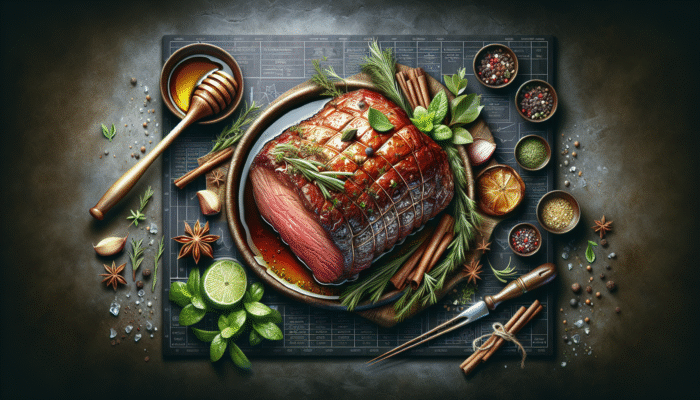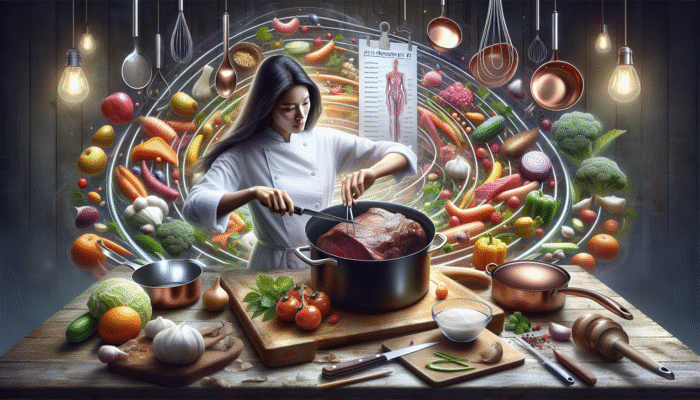Master the Art of Selecting the Ideal Meat Cut for an Irresistibly Tender Pot Roast
Choosing the most suitable cut of meat is crucial for crafting the ultimate succulent pot roast. The selection you make will significantly impact not just the overall flavour of the dish but also its tenderness and juiciness. By familiarising yourself with the different beef cuts and their distinct characteristics, you can create a pot roast that is not only delectably delicious but also remarkably tender, ensuring a delightful dining experience for all gathered around your table. Gaining this foundational knowledge is the initial step towards mastering the intricate art of pot roast preparation.
Why Beef Chuck is the Premier Choice for an Exceptional Pot Roast

When it comes to preparing pot roast, beef chuck undeniably stands out as the superior choice. This remarkable cut, sourced from the shoulder of the cow, is celebrated for its exceptional marbling, featuring delicate streaks of fat woven throughout the muscle. This marbling is of paramount importance; it melts away throughout the slow cooking process, resulting in meat that is not only tender but also infused with a rich, robust flavour. Additionally, the connective tissues present in beef chuck break down beautifully, further enhancing the overall succulence and moistness of your dish.
Numerous cultures have long embraced the use of beef chuck for pot roast, ranging from traditional American recipes to diverse European interpretations. The versatility of beef chuck accommodates various cooking methods, including braising and slow cooking, making it a cherished choice among home cooks worldwide. Utilising chuck not only yields an outstanding pot roast but also connects you to rich culinary traditions that span across continents, enriching your cooking experience while inviting you to explore a plethora of exciting flavours.
Understanding Meat Grades to Select High-Quality Cuts for Your Pot Roast
Grasping the grading system for meat is a fundamental yet frequently overlooked aspect that can dramatically influence the texture and flavour of your pot roast. Across many regions, beef is graded based on several factors such as marbling, age, and overall quality. In the United States, the Department of Agriculture (USDA) rates beef from Select to Prime, with Prime representing the highest quality available.
To ensure maximum tenderness in your pot roast, prioritise sourcing cuts with excellent marbling that fall within the Choice or Prime categories. These premium-grade cuts decompose beautifully during extended cooking times, resulting in a pot roast that practically melts in your mouth. While grading systems may vary across the globe, the essential principle remains the same: superior quality meat consistently yields exceptional results. Familiarising yourself with these grading systems will significantly aid you in choosing the perfect cut for your culinary endeavours, ensuring a deliciously unforgettable meal.
Exploring Alternative Cuts for Unique and Delectable Pot Roasts
Although beef chuck is the traditional favourite for pot roast, alternative cuts such as brisket or round can also produce remarkably tender results when prepared with care. Brisket, which is sourced from the breast region, is particularly revered in barbecue traditions, imparting a rich, beefy essence when braised over an extended period. Conversely, round cuts, while generally leaner, can become delightful and tender with appropriate cooking techniques, offering a healthier alternative without sacrificing flavour.
In various culinary traditions, these alternative cuts are celebrated for their distinctive flavours. For instance, brisket is a staple in Jewish cuisine, often slow-cooked for festive gatherings, while round cuts frequently feature in Italian ragùs. Exploring these alternatives not only enriches your culinary repertoire but also allows you to discover new and intriguing flavours and textures from around the globe, enhancing your pot roast experience and transforming each meal into a culinary adventure.
The Significance of Fat Content in Achieving the Perfect Pot Roast

The fat content in your chosen cut plays a pivotal role as a flavour carrier, making it essential to select a cut with the optimal amount of fat for a successful pot roast. While lean cuts may appear to be the healthier option, they often result in a drier dish. A well-cooked pot roast benefits from the natural fats that render down during cooking, keeping the meat moist while significantly enhancing its flavour profile.
When selecting your cut, strive for a balanced fat content. A cut with moderate fat will enrich your dish without overwhelming it. Engaging local butchers for their insights and recommendations can provide valuable guidance on which cuts perform best for pot roast across various culinary traditions. For example, in French cuisine, cuts with adequate fat content are revered for their ability to transform a simple meal into a remarkable culinary experience, highlighting the essential role of fat in traditional cooking.
Recognising the Importance of Meat Thickness for Even Cooking Results
The thickness of the meat is a vital factor that influences how evenly your pot roast cooks. Thicker cuts may necessitate longer cooking times, and ensuring a uniform thickness guarantees that every part of the roast reaches the desired tenderness at the same time. When preparing the meat, consider using a meat mallet or a knife to achieve an even thickness, or opt for a cut that is already well-portioned for the best results.
Another essential aspect is the size of your cooking vessel. Whether you choose a slow cooker or a Dutch oven, the shape and size can affect how heat circulates around the meat. Adjusting cooking times based on thickness while ensuring uniformity will greatly improve the tenderness and flavour of your pot roast. This meticulous attention to detail is a hallmark of successful cooks worldwide, ensuring a consistently delectable dish every time you prepare it.
Your Comprehensive Guide to Preparing Meat for Pot Roast Perfection
Preparation is a critical phase in unveiling the secrets to achieving a tender pot roast. Investing a little effort at this stage can significantly influence the flavour and texture of your final dish. Properly prepared meat not only enhances taste but also guarantees optimal tenderness, paving the way for a comforting and satisfying meal that everyone will thoroughly enjoy.
Trimming Excess Fat for an Ideal Balance of Flavour

While a certain amount of fat is necessary for flavour, excessive fat can lead to a greasy pot roast that detracts from the overall experience. Trimming away the outer layer of fat helps you achieve the right balance. Aim to leave a thin layer intact, as this will render down during cooking, imparting essential moisture and flavour without overwhelming the dish.
Different cultures have unique approaches to fat trimming. For example, traditional French cooking often emphasises retaining enough fat to enhance the dish, while health-conscious diets may favour leaner preparations. Understanding these cultural nuances can guide your trimming choices, allowing you to create a pot roast that aligns with your taste preferences while respecting the culinary traditions of various regions around the world.
Mastering Seasoning Techniques to Enrich Your Pot Roast’s Flavour
Employing the right seasoning techniques can elevate a pot roast from ordinary to extraordinary. Generously seasoning the meat with salt and pepper prior to cooking allows flavours to penetrate deeply, enhancing the overall taste significantly. Consider utilising a dry rub of herbs and spices tailored to your regional preferences; this could include garlic powder, paprika, or even a hint of cumin for a unique twist that reflects your personal culinary style.
Incorporating regional spices can infuse your pot roast with a distinct flavour profile that resonates with various culinary traditions. For example, a Moroccan-inspired pot roast might utilise spices like cinnamon and coriander, while an Italian approach could favour rosemary and oregano. Crafting a seasoning strategy that reflects diverse global flavours not only enriches the dish but also transforms it into a conversation starter at the dining table, inviting your guests to explore the culinary journey behind your creation.
The Essential Art of Browning Meat for Maximum Depth of Flavour
Browning the meat before slow cooking is a technique that should never be underestimated. This process caramelises the natural sugars found in the meat, resulting in a rich and complex flavour that forms the foundation of your pot roast. Whether you choose to brown the meat in a skillet or directly in your slow cooker, this step adds depth and richness that simpler cooking methods may lack.
The Maillard reaction, which occurs during the browning process, is a transformative phenomenon celebrated in various cuisines worldwide. In North American cooking, browning is a staple technique, while in Asian cuisines, searing meat before braising is similarly common. Embracing this technique can unlock the full potential of your pot roast, ensuring that it delivers that irresistible “wow” factor with every bite and making your meal memorable for all who partake.
Selecting the Optimal Cooking Method for Your Pot Roast
The cooking method you choose for your pot roast can significantly influence the final outcome. Each technique offers unique advantages and can be adapted to suit different lifestyles and preferences. Understanding these cooking methods will empower you to select one that aligns with your culinary goals and time constraints while still revealing the secrets to a tender pot roast.
The Incredible Benefits of Cooking with a Slow Cooker
A slow cooker is an excellent tool for preparing pot roast, allowing you to achieve tender, flavourful meat with minimal effort. By cooking the roast low and slow, you enable the collagen in the meat to break down gradually, resulting in a melt-in-your-mouth texture that is simply irresistible. This method also facilitates the development of deep, rich flavours as the meat interacts with the surrounding ingredients over several hours, enhancing the overall culinary experience.
Many home cooks appreciate the convenience of a slow cooker, as it allows for meal prep in the morning, enabling you to return home to a deliciously cooked pot roast by dinner time. The versatility of slow cookers has made them a staple in kitchens around the globe, with recipes tailored to local flavours and seasonal ingredients. This adaptability guarantees that no matter where you are, the comfort of a slow-cooked pot roast is always within reach, making it an ideal choice for busy families and individuals alike.
Oven Roasting Techniques: A Deliciously Different Approach
Oven roasting provides a fantastic alternative to slow cooking, achieving similar tenderness while adding the benefit of browning. By setting your oven to a low temperature, you can replicate the effects of a slow cooker while still achieving that desirable caramelisation on the meat’s surface, creating a delightful contrast in both texture and flavour.
This method offers flexibility in cooking times, which can be especially advantageous when preparing a meal for guests. Depending on your oven's capabilities and the size of your roast, oven roasting can create a beautifully balanced crust while keeping the inside tender and juicy. The enticing aroma that wafts through the kitchen during oven roasting is a universal pleasure, enhancing the communal experience of meal preparation and sharing, bringing everyone together around the dining table.
Discovering the Time-Saving Advantages of Pressure Cooking
Pressure cooking is a revolutionary method for those who are pressed for time but still desire a tender pot roast. This efficient technique dramatically reduces cooking time while maintaining the moisture and flavour that traditional pot roasts offer. By increasing the pressure within the cooker, the boiling point of water rises, allowing the meat to cook at higher temperatures and break down more rapidly, resulting in a deliciously tender roast.
Pressure cookers have gained immense popularity worldwide, particularly for their ability to create hearty meals in a fraction of the time required by traditional methods. Many cultures have embraced this technique, incorporating it into their culinary practices to prepare everything from stews to rice dishes quickly and efficiently. This time-saving approach does not compromise flavour; instead, it can produce a pot roast that is just as tender and flavourful as those slow-cooked for hours, making it an excellent option for busy weeknights.
Elevate Your Cooking with the Precision of Sous Vide Technique
Sous vide cooking is a precise method that guarantees consistent temperature control, resulting in a perfectly cooked pot roast every time. By vacuum-sealing the meat and immersing it in a water bath at a controlled temperature, you can achieve evenly cooked and moist results that are difficult to replicate with other cooking methods. While this technique does require specialised equipment, it is becoming increasingly popular among culinary enthusiasts who appreciate the scientific principles behind cooking.
Many fine dining establishments around the globe have adopted sous vide methods to elevate their dishes, showcasing the meticulous care that goes into each plate. This technique allows chefs to prepare food in advance, ensuring that it is ready to serve at the exact desired doneness. For home cooks looking to impress family and friends, mastering the sous vide technique can open up a world of culinary possibilities while ensuring that your pot roast remains tender, flavourful, and a true standout at any gathering.
Enhancing Your Pot Roast with the Right Liquids for Maximum Flavour
The choice of liquids you use to cook your pot roast can profoundly affect its flavour and overall quality. By selecting the appropriate liquids, you can enhance the richness of the dish while ensuring the meat remains moist and tender throughout the cooking process. Understanding the role of these liquids is crucial in uncovering the secrets to achieving a tender pot roast, ensuring that each bite is bursting with flavour.
Utilising Broth to Add Depth and Richness
Broth, whether beef or vegetable, serves as an excellent base for your pot roast. It not only adds crucial moisture, preventing the meat from drying out but also contributes depth and richness to the overall flavour profile. The choice between beef or vegetable broth can depend on your personal preference and dietary considerations, but both options work beautifully in a pot roast, enhancing the overall culinary experience.
In many culinary traditions, the use of homemade broth is highly regarded, as it brings a depth of flavour that store-bought options may lack. Across various cultures, you’ll find diverse techniques for making broth, from simmering bones for hours to infusing vegetables with fresh herbs. Integrating high-quality broth into your pot roast preparation can elevate the dish significantly, transforming it into a cherished recipe in your culinary repertoire that friends and family will rave about for years to come.
Incorporating Wine for an Unforgettable Flavour Profile
Integrating red wine into your pot roast is a classic technique for imparting a complex flavour profile that enhances your dish significantly. The acidity of the wine assists in tenderising the meat while contributing rich, nuanced notes that can elevate a simple meal to gourmet status. Whether you choose a robust Cabernet Sauvignon or a fruity Merlot, your selection of wine can greatly influence the final taste, making it a key ingredient in your pot roast preparation.
Wine serves not only as a flavour enhancer but also connects to cultural practices surrounding food and drink. For instance, in French cuisine, coq au vin—a dish that exemplifies the use of wine in cooking—has become iconic for its depth and richness. Through such examples, it’s clear that incorporating wine into your pot roast can create a link to culinary traditions, adding layers of complexity and delight to every bite, ensuring an unforgettable dining experience for you and your guests.
Harnessing the Benefits of Tomato Products for Enhanced Flavour
Tomato paste or sauce can serve as a secret weapon in your pot roast preparation. Tomatoes not only contribute a robust flavour but also assist in further tenderising the meat, enhancing the overall dish. The acidity present in tomatoes works wonders when paired with the rich flavours of beef, creating a harmonious balance that elevates your pot roast to new culinary heights.
In many cuisines, tomatoes are celebrated for their versatility—from Italian ragùs to Middle Eastern tagines, incorporating tomato products can enhance the dish's overall appeal. Experimenting with different tomato options, whether you prefer a concentrated paste or a chunky sauce, allows you to tailor the flavour to your liking. This adaptability can lead to uniquely delicious pot roasts that reflect a fusion of culinary traditions and your personal tastes, making your dish a standout feature at any gathering.
Maximising Flavour by Incorporating Vegetables and Aromatics
Vegetables and aromatics are fundamental in developing the flavour of your pot roast while also contributing texture and nutrition. The right combination can transform your dish into a well-rounded meal that delights the senses. Understanding how to incorporate these ingredients effectively is key to unlocking the secrets to a tender pot roast that will impress your guests and elevate your culinary skills.
Selecting the Best Root Vegetables to Enhance Your Pot Roast
Root vegetables such as carrots and potatoes are classic additions to any pot roast. These vegetables not only absorb the rich juices from the meat but also impart their own natural sweetness to the dish, creating a delightful balance of flavours. When choosing root vegetables, opt for those that are firm and fresh to ensure they hold up well during the long cooking process, maintaining their texture and enhancing the overall flavour.
In various culinary traditions, you might discover unique local root vegetables that can be substituted or added to your pot roast. For example, parsnips offer a sweeter alternative to carrots, while turnips or sweet potatoes can infuse their distinct flavours into the dish. Embracing seasonal produce from your region can create a pot roast that reflects local ingredients, enriching the dish further and showcasing the bounty of your area, making your meal both satisfying and memorable.
Enhancing Flavour with Onions and Garlic: The Essential Aromatics
Onions and garlic provide foundational flavours that significantly elevate the pot roast. Sautéing onions until they caramelise adds a rich sweetness that beautifully complements the beef. Meanwhile, garlic imparts aromatic depth and complexity, making it an essential ingredient in many pot roast recipes and enhancing the overall flavour profile.
In various cultures, the combination of onions and garlic serves as a staple starting point for countless dishes. From Italian soffritto to Indian masalas, these aromatics create a robust base for flavour development. By incorporating them into your pot roast, you not only adhere to traditional practices but also enrich the overall dining experience, making each forkful a delightful celebration of tastes and textures that will have everyone coming back for more.
Utilising Herbs for a Dynamic and Exciting Flavour Profile
Herbs, whether fresh or dried, are vital for enhancing the overall flavour profile of your pot roast. Classic choices like thyme and rosemary are popular for their ability to beautifully complement the rich flavours of beef. However, experimenting with herbs from various culinary traditions can also lead to exciting discoveries; consider adding bay leaves or even spices like coriander for a unique twist that sets your pot roast apart from the rest.
Herbs not only add complexity but also introduce a vibrant freshness to the dish. In Mediterranean cuisines, a sprinkle of fresh parsley can brighten up rich stews, while in Asian cooking, herbs like cilantro often provide a refreshing contrast to hearty dishes. Thoughtfully integrating herbs into your pot roast can transform the dish, making it a truly standout meal that captures the essence of global culinary traditions and showcases your creativity as a cook.
Boosting Nutrition with Leafy Greens for a Wholesome Touch
Incorporating leafy greens like spinach or kale towards the end of the cooking process can enhance both the nutritional value and the visual appeal of your pot roast. These greens not only introduce a splash of colour but also add a fresh element that balances the richness of the meat and other ingredients, creating a more wholesome and satisfying dish.
In many culinary traditions, adding greens to slow-cooked dishes is a common practice, often reflecting seasonal availability and health-conscious cooking. Including these leafy greens can also allow you to utilise any leftover vegetables in your fridge, boosting the meal's nutritional profile. Embracing this flexibility can lead to pot roasts that are not only comforting but also nourishing, ensuring a meal that is hearty, satisfying, and guilt-free for everyone at the table.
Mastering Cooking Times and Temperatures for Pot Roast Excellence
Understanding cooking times and temperatures is crucial for ensuring your pot roast turns out perfectly tender and flavourful. Knowing these variables will help you achieve the best results, leading to a deliciously satisfying dish that encapsulates the secrets to a tender pot roast and leaves everyone at your table craving seconds.
Determining the Optimal Cooking Time for Perfect Results
Cooking time can vary significantly depending on the size of your roast and the method employed. Generally, a pot roast will require anywhere from six to eight hours of cooking time when using a slow cooker, while oven-roasting may take a similar duration at low temperatures. A larger roast may benefit from extended cooking, allowing the collagen to break down fully and tenderising the meat to perfection, creating an unforgettable dining experience.
The key to success is to monitor the roast throughout the cooking process, checking for signs of tenderness. In cultures renowned for their mastery of slow-cooked dishes, such as the French and Italians, cooking time is often considered a critical aspect of the recipe. Paying close attention to these details will help you perfect your pot roast over time, ensuring consistent results that you and your loved ones will cherish and enjoy together.
Setting the Right Temperature for Optimal Pot Roast Results
The temperature at which you cook your pot roast is vital for achieving that tender, fall-apart texture that everyone loves. For oven roasting, aim for a low temperature of around 275°F (135°C). This low-and-slow approach allows gentle heat to penetrate the meat, breaking down tough fibres without drying them out, thereby ensuring a succulent pot roast every time you prepare it.
When using a slow cooker, set it to low for the best results. The gentle heat allows for even cooking, and the lid traps moisture, ensuring the roast remains succulent and flavourful throughout the cooking process. Across various culinary traditions, the importance of low temperatures for extended cooking times is a common theme, reflecting a deep understanding of flavour development and meat tenderness that has been refined over generations.
Checking for Doneness: The Key to Perfect Pot Roast
The ultimate test for a perfectly cooked pot roast is its tenderness. Using a meat thermometer can help ensure that the internal temperature reaches around 190°F (88°C). At this point, the collagen has broken down sufficiently, resulting in a fork-tender roast that practically shreds itself with minimal effort, ensuring a delightful meal for everyone.
Learning to check for doneness is a skill that home cooks develop over time. Many cultures have traditional methods for determining when a pot roast is ready, whether it’s the classic ‘fork test’ or visual cues like a deep, rich colour. Incorporating these practices into your cooking not only enhances your skills but also fosters a sense of tradition and connection to the meal you are preparing, making it a truly special occasion for everyone involved.
Your Questions Answered: Pot Roast FAQs for Home Chefs
Which Cut of Meat is Best for Pot Roast?
The best cut for pot roast is typically beef chuck, renowned for its marbling and connective tissue that breaks down during cooking, resulting in incredibly tender meat that melts in your mouth, providing a truly satisfying dining experience.
What is the Ideal Cooking Time for a Pot Roast?
Cooking time varies based on the method and size of the roast, but generally ranges from 6 to 8 hours on low in a slow cooker or oven at 275°F (135°C), ensuring optimal tenderness and flavour in your finished dish.
Should I Brown the Meat Before Cooking for Enhanced Flavor?
Yes, browning the meat is highly recommended as it adds rich, caramelised flavour and depth to the pot roast, enhancing the overall taste and making it truly delicious and memorable for all who enjoy it.
Can I Use a Slow Cooker for Pot Roast?
Absolutely! A slow cooker is ideal for pot roast, providing even cooking and tender meat with minimal effort, which is perfect for busy home cooks looking for convenience without compromising on taste.
What Liquids Should I Incorporate in My Pot Roast?
Utilising broth, wine, or tomato products can add depth and enhance the flavour profile while keeping the meat moist during cooking, ensuring a delightful and satisfying dish that everyone will love.
How Do I Know When My Pot Roast is Done Cooking?
Check the internal temperature; it should reach around 190°F (88°C) for fork-tender results, ensuring that the collagen has broken down and the meat is perfectly tender for your dining enjoyment.
Can I Add Vegetables to My Pot Roast for Extra Flavor?
Yes, absolutely! Root vegetables like carrots and potatoes, along with aromatics like onions and garlic, are great additions that enhance flavour, texture, and nutrition in your pot roast, creating a well-rounded meal.
Which Herbs Work Best in Pot Roast Preparation?
Herbs like thyme, rosemary, and bay leaves complement the beef's flavour beautifully. You can also experiment with other herbs based on regional culinary traditions for exciting variations and personal touches that elevate the dish.
Can I Cook Pot Roast the Day Before Serving for Enhanced Flavours?
Yes, cooking pot roast a day ahead allows flavours to meld beautifully. Simply reheat gently before serving for the best results, ensuring a delicious meal that’s ready to enjoy with family and friends.
Is Pot Roast a Healthy Meal Option for Families?
Pot roast can indeed be a healthy meal option, especially if you choose lean cuts of meat and incorporate plenty of vegetables for a balanced and nutritious meal that satisfies, making it a great family dinner choice.
Join Our Community on Facebook for More Culinary Tips!
The post Tender Pot Roast Secrets: Your Ultimate Cooking Guide appeared first on https://cookinggods.com
The Article Tender Pot Roast Secrets: Mastering the Perfect Recipe Was Found On https://limitsofstrategy.com

